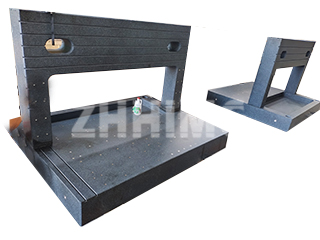At ZHONGHUI Group (ZHHIMG®), our role as a global leader in ultra-precision granite components requires a profound understanding of material science. Our proprietary ZHHIMG® Black Granite boasts an exceptional density of ≈ 3100 kg/m³, offering unparalleled rigidity, thermal stability, and non-magnetic properties—qualities essential for the foundation of modern semiconductor and metrology equipment. Yet, even the finest granite component requires rigorous assessment to confirm its quality and a deep understanding of the forces that threaten its dimensional stability. What simple, effective methods are used to authenticate material integrity, and what mechanics cause these stable structures to eventually deform?
Authenticating the Heart of Precision: Granite Material Assessment
Experienced engineers rely on fundamental, non-destructive tests to gauge the material integrity of a granite component. One such test is the Liquid Absorption Assessment. By applying a small drop of ink or water to the surface, the material’s porosity is immediately revealed. Rapid dispersion and absorption of the liquid indicate a loose, coarse-grained structure and high porosity—characteristics of inferior stone. Conversely, if the liquid beads and resists penetration, it signifies a dense, fine-grained structure and low absorption rate, a quality highly desirable for maintaining precision regardless of ambient humidity changes. However, it is important to remember that many high-precision surfaces are treated with a protective sealant; thus, resistance to penetration could be due to the sealant’s barrier, not exclusively the stone’s inherent quality.
A second crucial method is the Acoustic Integrity Test. Tapping the component and carefully assessing the sound produced offers insight into the internal structure. A clear, crisp, and ringing tone is the hallmark of a homogeneous, high-quality structure free from internal fissures or voids. A dull or muffled sound, however, suggests internal micro-cracks or a loosely compacted composition. While this test indicates the stone’s uniformity and relative hardness, it is important not to equate a ringing sound solely with dimensional accuracy, as the acoustic output is also linked to the component’s unique size and geometry.
The Mechanics of Deformation: Why “Permanent” Structures Change
ZHHIMG® components are complex assemblies, often featuring intricate drilling for steel inserts and precise grooving, necessitating technical requirements far exceeding those of simple surface plates. While highly stable, even these materials are subject to mechanical laws that dictate deformation over a lifespan. Understanding the four primary modes of structural change is key to preventative design:
Deformation by Tension or Compression occurs when equal and opposite forces act directly along the axis of the component, leading to either an elongation or a shortening of the granite member. When forces are applied perpendicular to the axis, or by opposing moments, the component undergoes Bending, where the straight axis transforms into a curve—the most common failure mode under uneven loading. A rotational deformation known as Torsion occurs when two equal and opposite force couples act perpendicular to the component’s axis, causing internal sections to twist relative to one another. Finally, Shear deformation is characterized by the relative parallel sliding of two parts of the component along the direction of the applied forces, typically caused by lateral external forces. These forces ultimately determine the component’s life cycle and necessitate periodic inspection.
Maintaining Integrity: Protocols for Sustained Accuracy
To ensure the ZHHIMG® standard of precision is preserved, technicians must adhere to strict operational protocols. When utilizing metrology tools like granite straight edges or parallels, the equipment’s calibration must be confirmed first. Both the measuring surface and the component’s working face must be meticulously cleaned to prevent debris from compromising the contact plane. Crucially, the straight edge should never be dragged across the surface during measurement; instead, it must be measured at one point, lifted entirely, and then repositioned for the next reading. This practice prevents microscopic wear and potential damage to the nanometer-level flatness. Furthermore, to prevent premature structural fatigue, the component’s load capacity must never be exceeded, and the surface should be protected from sudden, strong impacts. By upholding these disciplined protocols, the inherent, long-term stability of the ZHHIMG® granite foundation can be successfully maintained, ensuring the continuous precision required by the ultra-demanding aerospace and microelectronics industries.
Post time: Nov-19-2025

